Critical Analysis of Livingston et al. (2010) BMJ Research Article
VerifiedAdded on 2022/12/01
|7
|1819
|481
Report
AI Summary
This report provides a critical analysis of the research article by Livingston et al. (2010) published in the BMJ, focusing on a qualitative study of family carers in the UK. The analysis evaluates the study's validity, the methodology employed (ethnographic observation), the results, and the application of the findings. The report assesses the study's design, data collection methods, ethical considerations, and the conclusions drawn by the researchers. It also examines the study's contribution to existing knowledge and its implications for clinical practice, particularly in the context of healthcare research. The analysis highlights the strengths of the study, such as the use of ethnographic observation for in-depth data collection, and discusses the importance of the findings in improving infant outcomes after birth. The report concludes that the study meets the criteria of a robust qualitative research study and suggests directions for future research in the field.
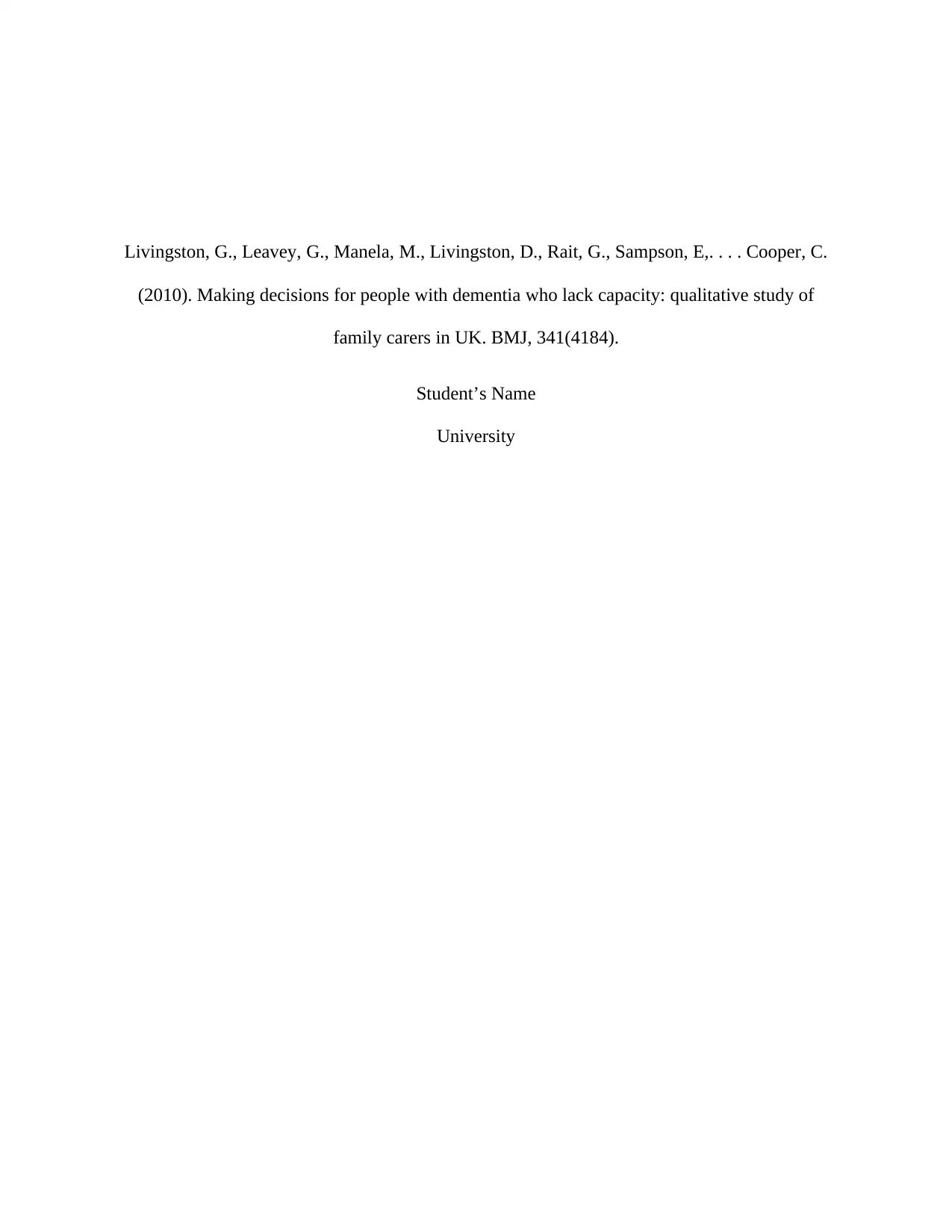
Livingston, G., Leavey, G., Manela, M., Livingston, D., Rait, G., Sampson, E,. . . . Cooper, C.
(2010). Making decisions for people with dementia who lack capacity: qualitative study of
family carers in UK. BMJ, 341(4184).
Student’s Name
University
(2010). Making decisions for people with dementia who lack capacity: qualitative study of
family carers in UK. BMJ, 341(4184).
Student’s Name
University
Paraphrase This Document
Need a fresh take? Get an instant paraphrase of this document with our AI Paraphraser
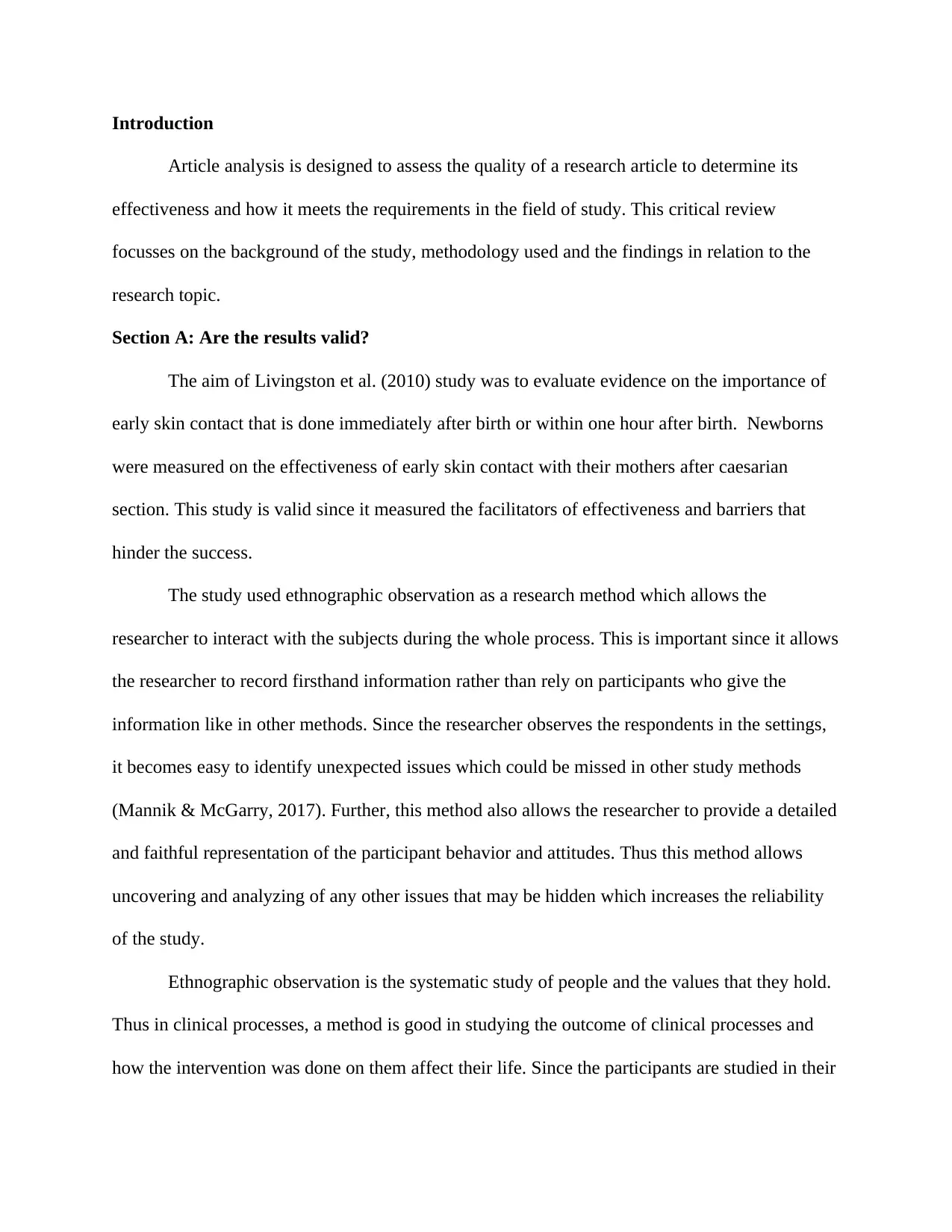
Introduction
Article analysis is designed to assess the quality of a research article to determine its
effectiveness and how it meets the requirements in the field of study. This critical review
focusses on the background of the study, methodology used and the findings in relation to the
research topic.
Section A: Are the results valid?
The aim of Livingston et al. (2010) study was to evaluate evidence on the importance of
early skin contact that is done immediately after birth or within one hour after birth. Newborns
were measured on the effectiveness of early skin contact with their mothers after caesarian
section. This study is valid since it measured the facilitators of effectiveness and barriers that
hinder the success.
The study used ethnographic observation as a research method which allows the
researcher to interact with the subjects during the whole process. This is important since it allows
the researcher to record firsthand information rather than rely on participants who give the
information like in other methods. Since the researcher observes the respondents in the settings,
it becomes easy to identify unexpected issues which could be missed in other study methods
(Mannik & McGarry, 2017). Further, this method also allows the researcher to provide a detailed
and faithful representation of the participant behavior and attitudes. Thus this method allows
uncovering and analyzing of any other issues that may be hidden which increases the reliability
of the study.
Ethnographic observation is the systematic study of people and the values that they hold.
Thus in clinical processes, a method is good in studying the outcome of clinical processes and
how the intervention was done on them affect their life. Since the participants are studied in their
Article analysis is designed to assess the quality of a research article to determine its
effectiveness and how it meets the requirements in the field of study. This critical review
focusses on the background of the study, methodology used and the findings in relation to the
research topic.
Section A: Are the results valid?
The aim of Livingston et al. (2010) study was to evaluate evidence on the importance of
early skin contact that is done immediately after birth or within one hour after birth. Newborns
were measured on the effectiveness of early skin contact with their mothers after caesarian
section. This study is valid since it measured the facilitators of effectiveness and barriers that
hinder the success.
The study used ethnographic observation as a research method which allows the
researcher to interact with the subjects during the whole process. This is important since it allows
the researcher to record firsthand information rather than rely on participants who give the
information like in other methods. Since the researcher observes the respondents in the settings,
it becomes easy to identify unexpected issues which could be missed in other study methods
(Mannik & McGarry, 2017). Further, this method also allows the researcher to provide a detailed
and faithful representation of the participant behavior and attitudes. Thus this method allows
uncovering and analyzing of any other issues that may be hidden which increases the reliability
of the study.
Ethnographic observation is the systematic study of people and the values that they hold.
Thus in clinical processes, a method is good in studying the outcome of clinical processes and
how the intervention was done on them affect their life. Since the participants are studied in their
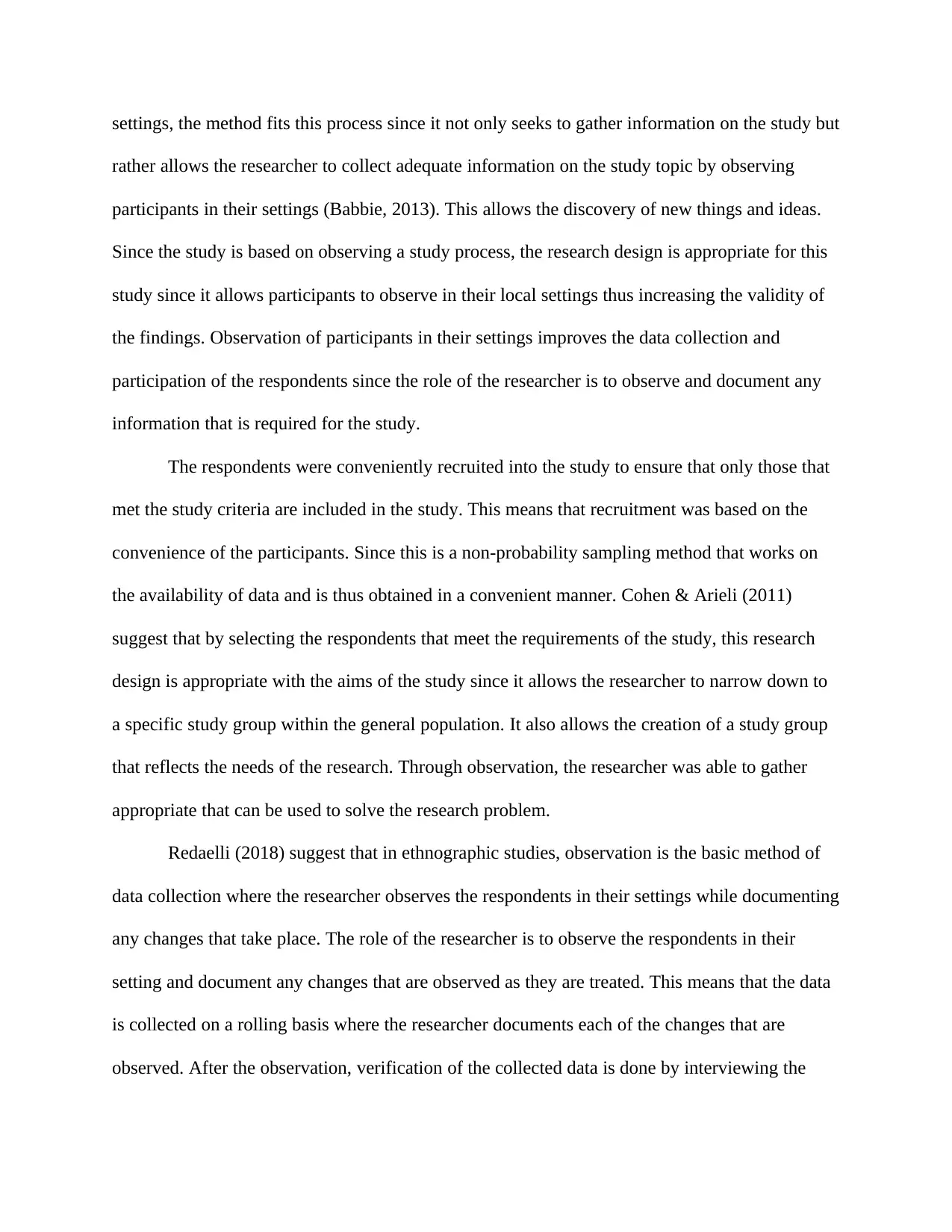
settings, the method fits this process since it not only seeks to gather information on the study but
rather allows the researcher to collect adequate information on the study topic by observing
participants in their settings (Babbie, 2013). This allows the discovery of new things and ideas.
Since the study is based on observing a study process, the research design is appropriate for this
study since it allows participants to observe in their local settings thus increasing the validity of
the findings. Observation of participants in their settings improves the data collection and
participation of the respondents since the role of the researcher is to observe and document any
information that is required for the study.
The respondents were conveniently recruited into the study to ensure that only those that
met the study criteria are included in the study. This means that recruitment was based on the
convenience of the participants. Since this is a non-probability sampling method that works on
the availability of data and is thus obtained in a convenient manner. Cohen & Arieli (2011)
suggest that by selecting the respondents that meet the requirements of the study, this research
design is appropriate with the aims of the study since it allows the researcher to narrow down to
a specific study group within the general population. It also allows the creation of a study group
that reflects the needs of the research. Through observation, the researcher was able to gather
appropriate that can be used to solve the research problem.
Redaelli (2018) suggest that in ethnographic studies, observation is the basic method of
data collection where the researcher observes the respondents in their settings while documenting
any changes that take place. The role of the researcher is to observe the respondents in their
setting and document any changes that are observed as they are treated. This means that the data
is collected on a rolling basis where the researcher documents each of the changes that are
observed. After the observation, verification of the collected data is done by interviewing the
rather allows the researcher to collect adequate information on the study topic by observing
participants in their settings (Babbie, 2013). This allows the discovery of new things and ideas.
Since the study is based on observing a study process, the research design is appropriate for this
study since it allows participants to observe in their local settings thus increasing the validity of
the findings. Observation of participants in their settings improves the data collection and
participation of the respondents since the role of the researcher is to observe and document any
information that is required for the study.
The respondents were conveniently recruited into the study to ensure that only those that
met the study criteria are included in the study. This means that recruitment was based on the
convenience of the participants. Since this is a non-probability sampling method that works on
the availability of data and is thus obtained in a convenient manner. Cohen & Arieli (2011)
suggest that by selecting the respondents that meet the requirements of the study, this research
design is appropriate with the aims of the study since it allows the researcher to narrow down to
a specific study group within the general population. It also allows the creation of a study group
that reflects the needs of the research. Through observation, the researcher was able to gather
appropriate that can be used to solve the research problem.
Redaelli (2018) suggest that in ethnographic studies, observation is the basic method of
data collection where the researcher observes the respondents in their settings while documenting
any changes that take place. The role of the researcher is to observe the respondents in their
setting and document any changes that are observed as they are treated. This means that the data
is collected on a rolling basis where the researcher documents each of the changes that are
observed. After the observation, verification of the collected data is done by interviewing the
⊘ This is a preview!⊘
Do you want full access?
Subscribe today to unlock all pages.

Trusted by 1+ million students worldwide
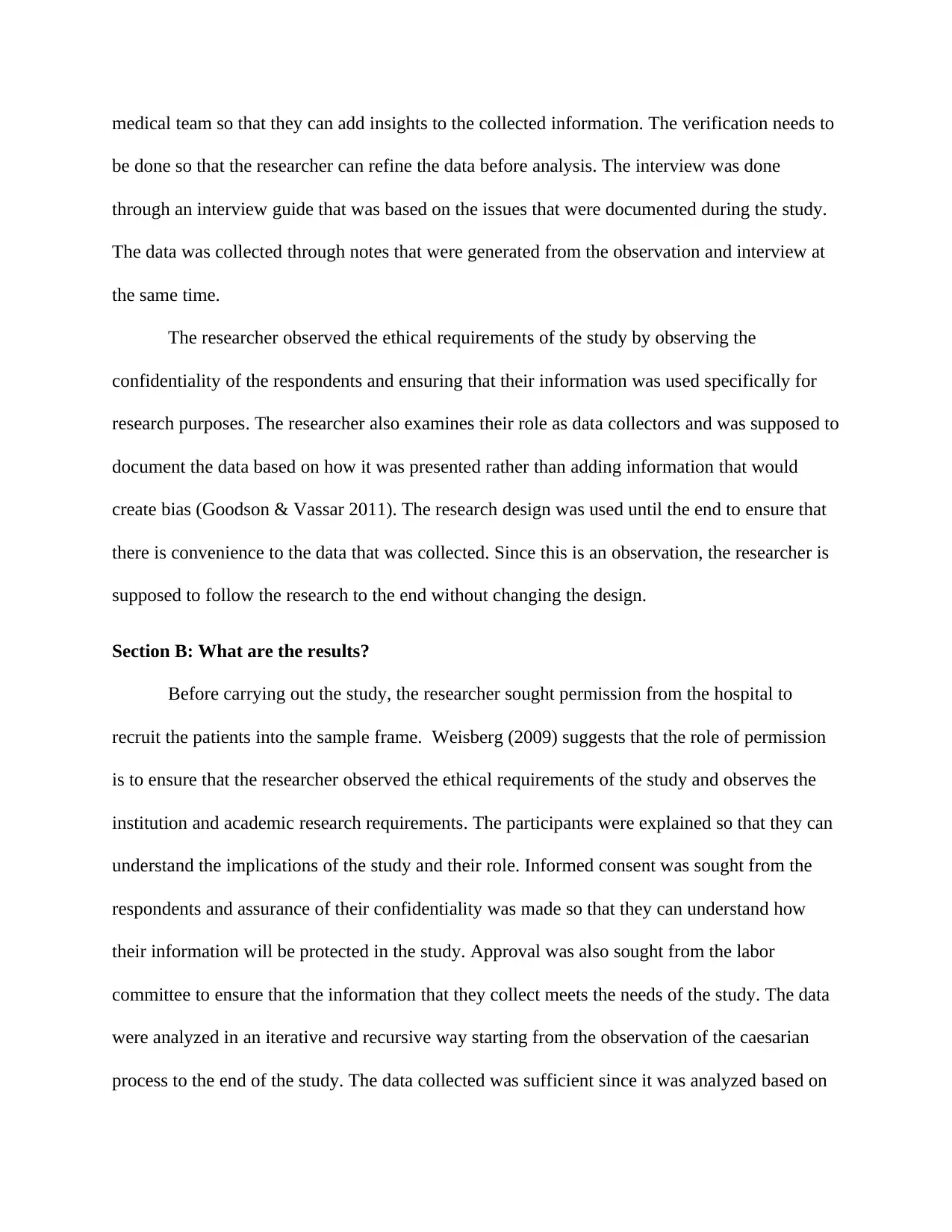
medical team so that they can add insights to the collected information. The verification needs to
be done so that the researcher can refine the data before analysis. The interview was done
through an interview guide that was based on the issues that were documented during the study.
The data was collected through notes that were generated from the observation and interview at
the same time.
The researcher observed the ethical requirements of the study by observing the
confidentiality of the respondents and ensuring that their information was used specifically for
research purposes. The researcher also examines their role as data collectors and was supposed to
document the data based on how it was presented rather than adding information that would
create bias (Goodson & Vassar 2011). The research design was used until the end to ensure that
there is convenience to the data that was collected. Since this is an observation, the researcher is
supposed to follow the research to the end without changing the design.
Section B: What are the results?
Before carrying out the study, the researcher sought permission from the hospital to
recruit the patients into the sample frame. Weisberg (2009) suggests that the role of permission
is to ensure that the researcher observed the ethical requirements of the study and observes the
institution and academic research requirements. The participants were explained so that they can
understand the implications of the study and their role. Informed consent was sought from the
respondents and assurance of their confidentiality was made so that they can understand how
their information will be protected in the study. Approval was also sought from the labor
committee to ensure that the information that they collect meets the needs of the study. The data
were analyzed in an iterative and recursive way starting from the observation of the caesarian
process to the end of the study. The data collected was sufficient since it was analyzed based on
be done so that the researcher can refine the data before analysis. The interview was done
through an interview guide that was based on the issues that were documented during the study.
The data was collected through notes that were generated from the observation and interview at
the same time.
The researcher observed the ethical requirements of the study by observing the
confidentiality of the respondents and ensuring that their information was used specifically for
research purposes. The researcher also examines their role as data collectors and was supposed to
document the data based on how it was presented rather than adding information that would
create bias (Goodson & Vassar 2011). The research design was used until the end to ensure that
there is convenience to the data that was collected. Since this is an observation, the researcher is
supposed to follow the research to the end without changing the design.
Section B: What are the results?
Before carrying out the study, the researcher sought permission from the hospital to
recruit the patients into the sample frame. Weisberg (2009) suggests that the role of permission
is to ensure that the researcher observed the ethical requirements of the study and observes the
institution and academic research requirements. The participants were explained so that they can
understand the implications of the study and their role. Informed consent was sought from the
respondents and assurance of their confidentiality was made so that they can understand how
their information will be protected in the study. Approval was also sought from the labor
committee to ensure that the information that they collect meets the needs of the study. The data
were analyzed in an iterative and recursive way starting from the observation of the caesarian
process to the end of the study. The data collected was sufficient since it was analyzed based on
Paraphrase This Document
Need a fresh take? Get an instant paraphrase of this document with our AI Paraphraser
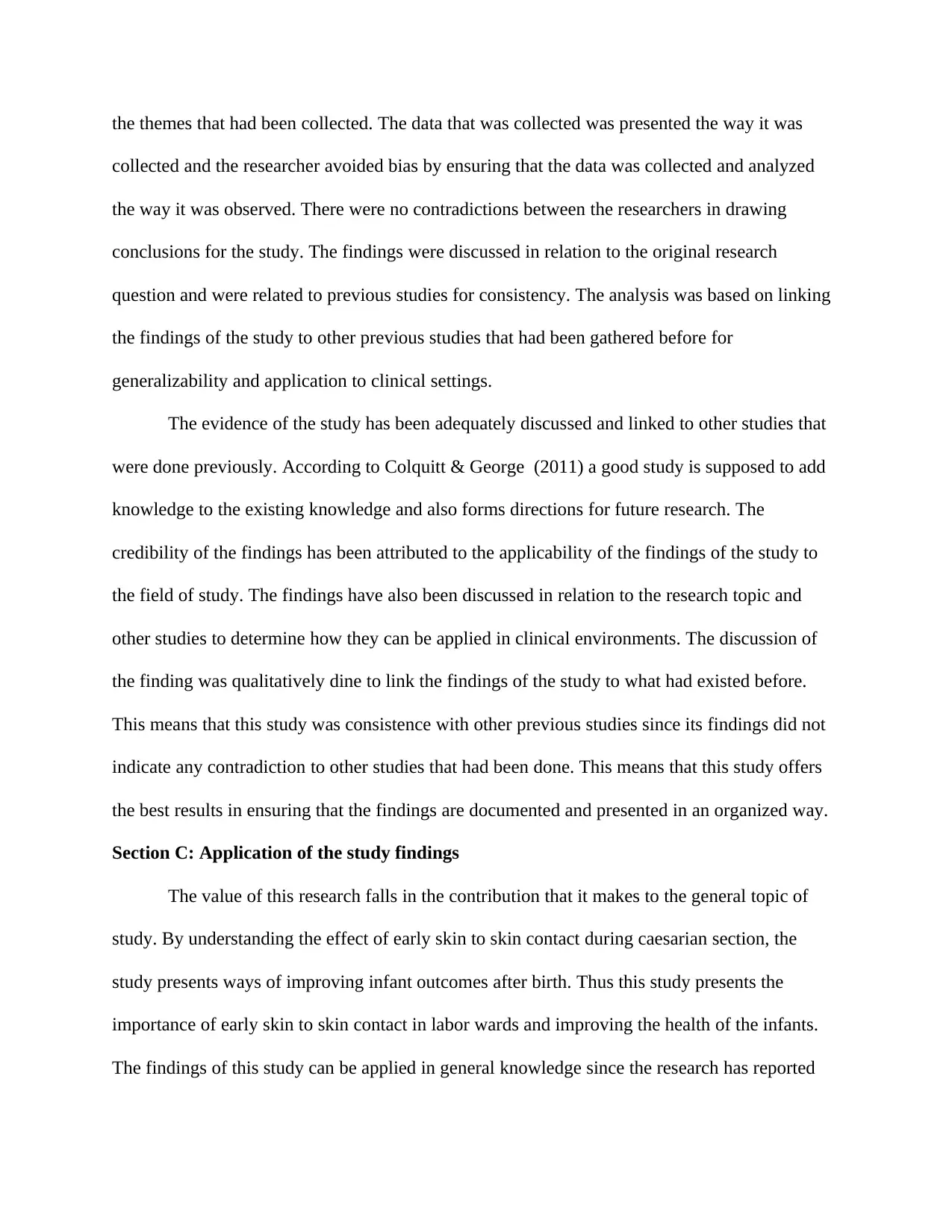
the themes that had been collected. The data that was collected was presented the way it was
collected and the researcher avoided bias by ensuring that the data was collected and analyzed
the way it was observed. There were no contradictions between the researchers in drawing
conclusions for the study. The findings were discussed in relation to the original research
question and were related to previous studies for consistency. The analysis was based on linking
the findings of the study to other previous studies that had been gathered before for
generalizability and application to clinical settings.
The evidence of the study has been adequately discussed and linked to other studies that
were done previously. According to Colquitt & George (2011) a good study is supposed to add
knowledge to the existing knowledge and also forms directions for future research. The
credibility of the findings has been attributed to the applicability of the findings of the study to
the field of study. The findings have also been discussed in relation to the research topic and
other studies to determine how they can be applied in clinical environments. The discussion of
the finding was qualitatively dine to link the findings of the study to what had existed before.
This means that this study was consistence with other previous studies since its findings did not
indicate any contradiction to other studies that had been done. This means that this study offers
the best results in ensuring that the findings are documented and presented in an organized way.
Section C: Application of the study findings
The value of this research falls in the contribution that it makes to the general topic of
study. By understanding the effect of early skin to skin contact during caesarian section, the
study presents ways of improving infant outcomes after birth. Thus this study presents the
importance of early skin to skin contact in labor wards and improving the health of the infants.
The findings of this study can be applied in general knowledge since the research has reported
collected and the researcher avoided bias by ensuring that the data was collected and analyzed
the way it was observed. There were no contradictions between the researchers in drawing
conclusions for the study. The findings were discussed in relation to the original research
question and were related to previous studies for consistency. The analysis was based on linking
the findings of the study to other previous studies that had been gathered before for
generalizability and application to clinical settings.
The evidence of the study has been adequately discussed and linked to other studies that
were done previously. According to Colquitt & George (2011) a good study is supposed to add
knowledge to the existing knowledge and also forms directions for future research. The
credibility of the findings has been attributed to the applicability of the findings of the study to
the field of study. The findings have also been discussed in relation to the research topic and
other studies to determine how they can be applied in clinical environments. The discussion of
the finding was qualitatively dine to link the findings of the study to what had existed before.
This means that this study was consistence with other previous studies since its findings did not
indicate any contradiction to other studies that had been done. This means that this study offers
the best results in ensuring that the findings are documented and presented in an organized way.
Section C: Application of the study findings
The value of this research falls in the contribution that it makes to the general topic of
study. By understanding the effect of early skin to skin contact during caesarian section, the
study presents ways of improving infant outcomes after birth. Thus this study presents the
importance of early skin to skin contact in labor wards and improving the health of the infants.
The findings of this study can be applied in general knowledge since the research has reported
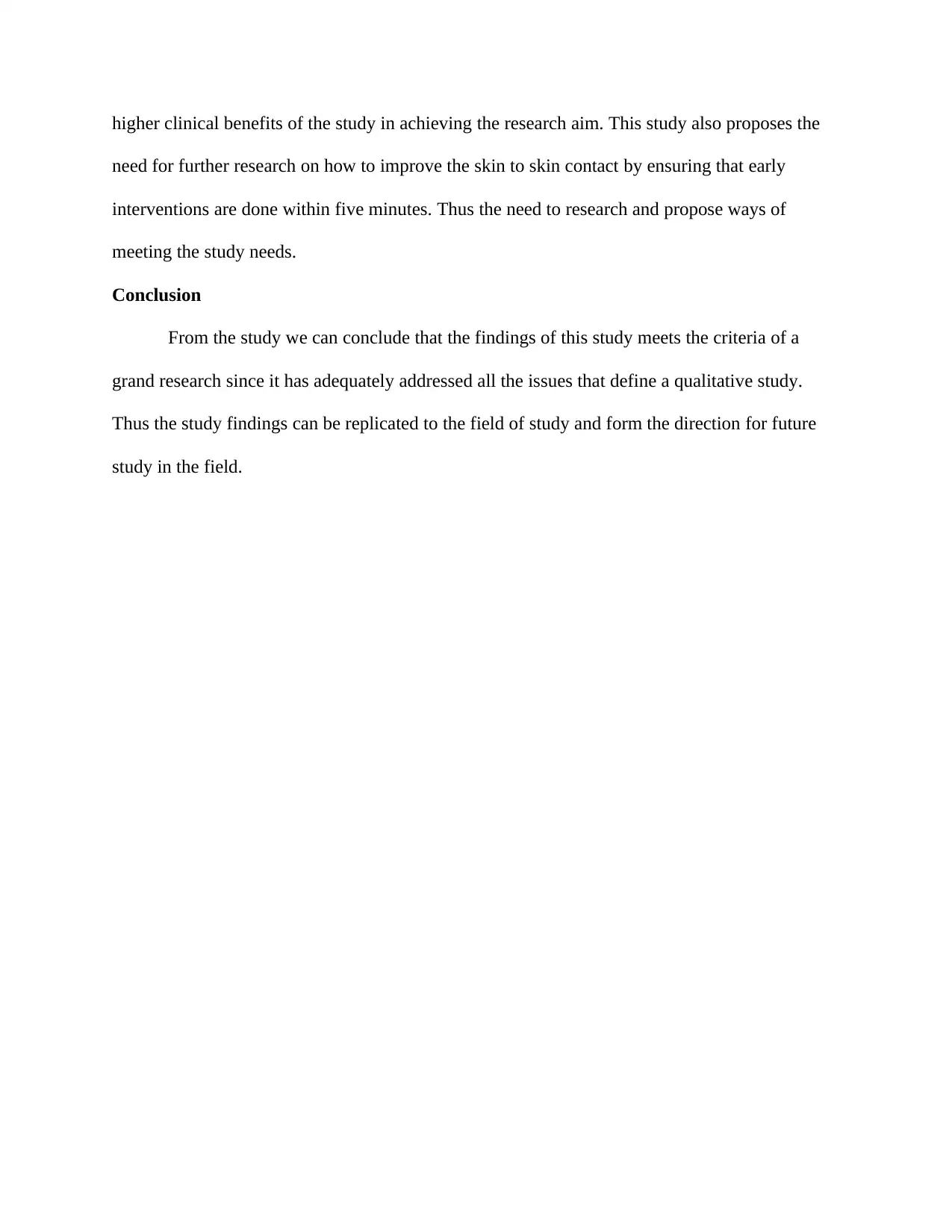
higher clinical benefits of the study in achieving the research aim. This study also proposes the
need for further research on how to improve the skin to skin contact by ensuring that early
interventions are done within five minutes. Thus the need to research and propose ways of
meeting the study needs.
Conclusion
From the study we can conclude that the findings of this study meets the criteria of a
grand research since it has adequately addressed all the issues that define a qualitative study.
Thus the study findings can be replicated to the field of study and form the direction for future
study in the field.
need for further research on how to improve the skin to skin contact by ensuring that early
interventions are done within five minutes. Thus the need to research and propose ways of
meeting the study needs.
Conclusion
From the study we can conclude that the findings of this study meets the criteria of a
grand research since it has adequately addressed all the issues that define a qualitative study.
Thus the study findings can be replicated to the field of study and form the direction for future
study in the field.
⊘ This is a preview!⊘
Do you want full access?
Subscribe today to unlock all pages.

Trusted by 1+ million students worldwide
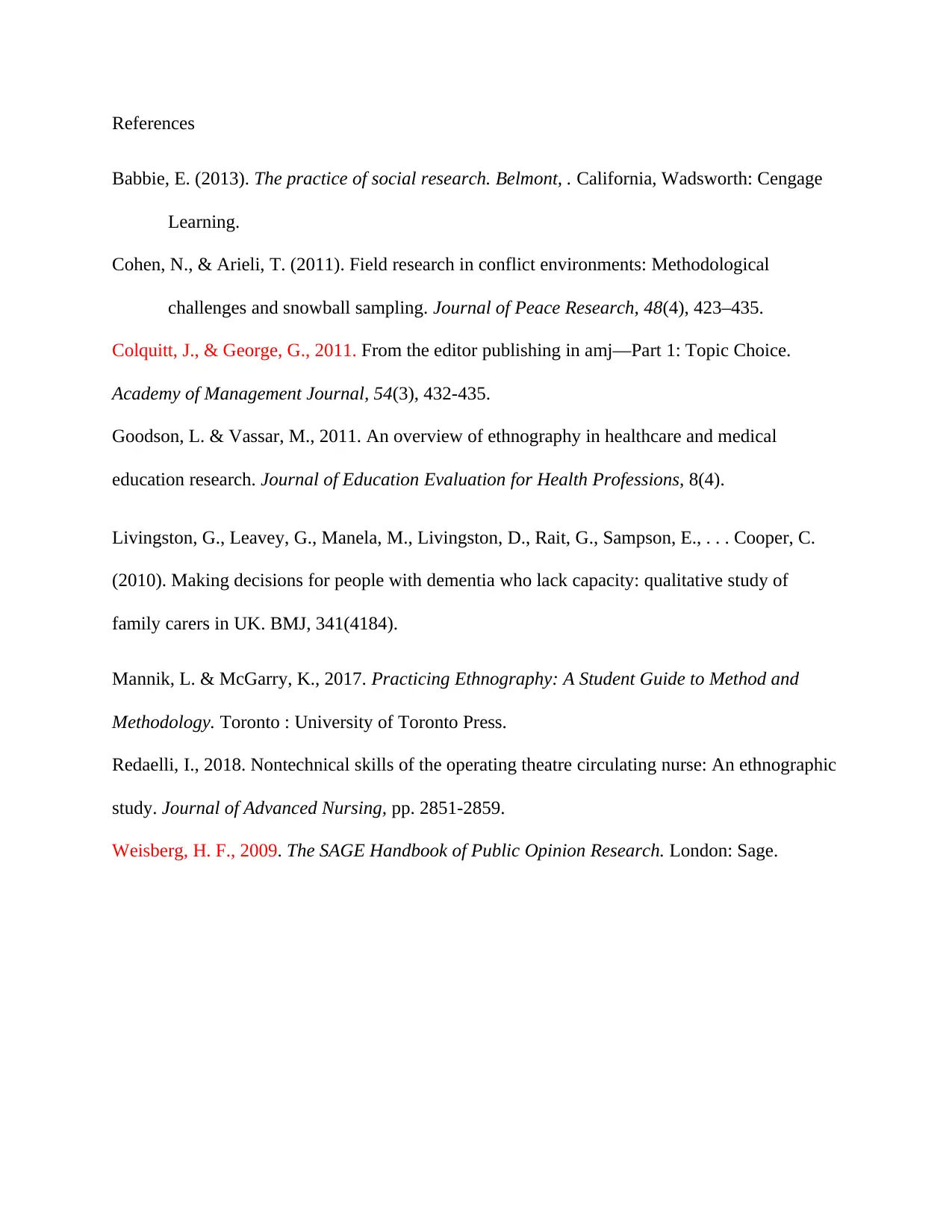
References
Babbie, E. (2013). The practice of social research. Belmont, . California, Wadsworth: Cengage
Learning.
Cohen, N., & Arieli, T. (2011). Field research in conflict environments: Methodological
challenges and snowball sampling. Journal of Peace Research, 48(4), 423–435.
Colquitt, J., & George, G., 2011. From the editor publishing in amj—Part 1: Topic Choice.
Academy of Management Journal, 54(3), 432-435.
Goodson, L. & Vassar, M., 2011. An overview of ethnography in healthcare and medical
education research. Journal of Education Evaluation for Health Professions, 8(4).
Livingston, G., Leavey, G., Manela, M., Livingston, D., Rait, G., Sampson, E., . . . Cooper, C.
(2010). Making decisions for people with dementia who lack capacity: qualitative study of
family carers in UK. BMJ, 341(4184).
Mannik, L. & McGarry, K., 2017. Practicing Ethnography: A Student Guide to Method and
Methodology. Toronto : University of Toronto Press.
Redaelli, I., 2018. Nontechnical skills of the operating theatre circulating nurse: An ethnographic
study. Journal of Advanced Nursing, pp. 2851-2859.
Weisberg, H. F., 2009. The SAGE Handbook of Public Opinion Research. London: Sage.
Babbie, E. (2013). The practice of social research. Belmont, . California, Wadsworth: Cengage
Learning.
Cohen, N., & Arieli, T. (2011). Field research in conflict environments: Methodological
challenges and snowball sampling. Journal of Peace Research, 48(4), 423–435.
Colquitt, J., & George, G., 2011. From the editor publishing in amj—Part 1: Topic Choice.
Academy of Management Journal, 54(3), 432-435.
Goodson, L. & Vassar, M., 2011. An overview of ethnography in healthcare and medical
education research. Journal of Education Evaluation for Health Professions, 8(4).
Livingston, G., Leavey, G., Manela, M., Livingston, D., Rait, G., Sampson, E., . . . Cooper, C.
(2010). Making decisions for people with dementia who lack capacity: qualitative study of
family carers in UK. BMJ, 341(4184).
Mannik, L. & McGarry, K., 2017. Practicing Ethnography: A Student Guide to Method and
Methodology. Toronto : University of Toronto Press.
Redaelli, I., 2018. Nontechnical skills of the operating theatre circulating nurse: An ethnographic
study. Journal of Advanced Nursing, pp. 2851-2859.
Weisberg, H. F., 2009. The SAGE Handbook of Public Opinion Research. London: Sage.
1 out of 7
Related Documents
Your All-in-One AI-Powered Toolkit for Academic Success.
+13062052269
info@desklib.com
Available 24*7 on WhatsApp / Email
![[object Object]](/_next/static/media/star-bottom.7253800d.svg)
Unlock your academic potential
Copyright © 2020–2025 A2Z Services. All Rights Reserved. Developed and managed by ZUCOL.





